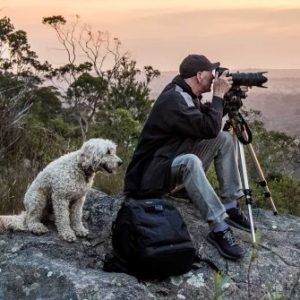Wombat Man
Words: Michael Sharp.
Photography: Ashley Mackevicius.
John Creighton was born and bred in New Orleans, Louisiana. Growing up, he loved to explore the surrounding swamps with their alligators, snakes, deer, wild pigs, squirrels, racoons and beautiful birds.
After serving in the army, love brought him to Australia and a few decades later, having settled in The Southern Highlands, he has decided to devote his life to caring for the region’s bare-nosed wombats.
There have been several significant turning points in the life of John Creighton, but perhaps the most unexpected occurred soon after he volunteered to bottle-feed a couple of young wombats in 2014. He had been amazed to see a woman doing it casually in a salon in Bowral, made some inquiries and obtained the necessary licence.
“Before long I had two little wombats in my care and I loved that,” he says with the memory still fresh and his piercing eyes shining. “I got hooked.”
John had enjoyed a close connection with nature since he was a boy, he had quickly discovered that wombats were surprisingly intelligent – but then something special happened one winter’s night.
“I’d just finished feeding one of them his bottle,” he says softly. “He pushed back slowly and was looking at me. He looked like he had something to say to me. And then he reached up and took my beanie off my head. He locked eyes on me, smelt the beanie and then he brought it to his heart, like this. He kept staring at me and he leaned into me. Then he gave me my beanie back with his two hands.
“That was the calling. I said: ‘I’m going to work for you guys.’”
Thirty years earlier, John thought the US Army would be his career for life. But after completing degrees in history and sociology, and adding a diploma of education, he decided to become a teacher while continuing to serve in the Army Reserve. He met an Australian woman in Louisiana in 1988 and travelled Down Under to spend some time with her. He and Rossana were married six months later and they have been married for over 30 years.
They first lived in Liverpool, in Sydney’s south-west, and John worked as a teacher and counsellor with Uniting Burnside.
“I was working with young men in the Campbelltown area and was a disciple of Steve Biddulph. One day I tried to break up a fight, as older boys were bullying a young boy with Tourette’s Syndrome, and in doing so I ended up with serious damage to my neck and was unable to work after that. I was prescribed heavy medication, I wore a neck brace and used a stroller like a walking frame – trying to hide my injury as I was walking my baby daughter.
“You can go two ways in that situation,” John says matter-of-factly. “You can become angry, depressed, alcoholic, miserable to be around and lose your self and your family or you can fight for what you’ve got. I decided to fight and to focus on raising our daughter and do the best I could with what I had left.”
The Creighton family moved to Bundanoon in The Southern Highlands in 2000 and are still living in the same house today.
“It wasn’t until we moved to Bundanoon that I really connected to Australia in a big way, because we were so close to nature here. Our daughter grew up hand feeding King Parrots and she thinks that’s just normal.”




It was when his daughter was about 12, and becoming more independent, that John decided to volunteer to raise wombats – which led to the unexpected epiphany with the beanie-loving baby marsupial. He soon discovered there were major challenges for releasing rehabilitated wombats safely and, after attending a Wombat Protection Society conference in 2015, learned that mange was a huge problem.
Mange is a disease caused by the parasitic mite, Sarcoptes scabiei – the name itself sounds appropriately revolting. Brought to Australia by Europeans and their animals, the mites burrow into the wombat resulting in crusty skin and hair loss. The wombats become extremely itchy and their scratching causes wounds which become infected. This results in the wombat losing condition, becoming dehydrated and malnourished – and many die.
John found that the major animal welfare groups didn’t want to deal with mange because it was seen as too hard and the medicine was expensive. He decided this was a battle that had to be fought so he established Wombat Care Bundanoon in 2015 and put his focus on treating mange as well as filling any wombat welfare needs not covered by other wildlife groups.
In 2019, just four years after establishing Wombat Care Bundanoon, John received the Australian Wildlife Society’s prestigious Wildlife Rehabilitation Award for his work.
“In the field,” the Society stated, “John follows wombats and installs medicated burrow flaps. The wombats become treated for mange when they enter or leave their burrows…John runs community workshops, attends conferences and manages volunteers. A group of 16 university students, and their teacher, were inspired by John’s work and flew over from California to volunteer their time at Wombat Care Bundanoon. John has an in-depth understanding of the implications of mange for wombat populations on a broader ecological scale. John educates children about wombat care and biology at local schools. John also engages with and encourages the wider community to take action on all aspects of wombat conservation and hopes to preserve the Australian icon for future generations.”
In his acceptance speech, John said: “Wildlife rehabilitation is hard work. It is physically and emotionally demanding, but it is also affirming, uniting and beautiful.”
When John refers to “hard work”, it is no understatement. He spends hours on his knees, often on cold rainy nights, rescuing wild animals that can weigh 35 kilograms and will bite and scratch because they are frightened. His daily uniform – which incorporates a lot of oilskin over second hand shirts from Vinnie’s – is chosen because it can cope with dirt, mud and formidable wombat teeth and claws. His signature Indiana Jones Fedora hat provides protection from both sun and rain.
When Creighton won the Australian Wildlife Society award in 2019, no one knew that unprecedented challenges were on the horizon – drought then bushfire then floods.
During the 2019 drought, Creighton played a major role energising the local community to get as much food and water to starving and dehydrated animals – not just wombats – as possible. And then the fires came.
“After I decided our house was safe, I went to an area I knew very well. I took medicines and blankets – but there was nothing. Everything was shades of grey and black, the ground was hot like sand and not a single bird was there to be heard. It was truly like a scene from another world. I found some animal bones, clearly wombat bones, and they had been burnt so badly you could crush them easily in your hand. I thought everything was gone, but as the sun came up that morning I saw some wombats coming out of burrows. They had survived by going deep underground, blocking the smoke with their butts like a cork and surviving on the air in their burrow. When they emerged, they were already thirsty and starving. There was no food and there was none of the usual smells that they knew and rely on. They have poor eyesight but a great sense of smell, keener than that of bloodhounds, and without those smells that illustrated their worlds, they didn’t quite know what to do.”
And then the rains came, hard and heavy.
“The ground was so dry that the rain caused burrows to collapse and clog up. The wombats got water and mud in their lungs and this led to infections. A lot of them had to be euthanised. It was a nightmare. I never experienced anything like that in all my years in the Army.”





Wombat Care Bundanoon itself has been flooded out of its former burrow and while some generous locals currently allow him to use their land and sheds to rehabilitate wombats, he hopes to find a long-term site for the organisation in the area. Volunteers with the appropriate qualifications are always welcome.
John takes several wombat care calls during our interview and I can see that behind his obvious energy, his work is physically and mentally draining.
I ask why is he so passionate about rehabilitating mangy marsupials in The Southern Highlands, more than 14,000 kilometres from the Louisiana swamps where he spent the first three decades of his life?
“When we love someone or something, it is amazing how much of ourselves we will dedicate to their welfare, wellbeing and care,” he says. “We do our absolute best, regardless of the price or time spent, in order to bring positive change. I saw a glaring, desperate need such that I’d never seen in my life and I knew it simply needed to be addressed. They have so much up against them now. Once I saw the scale of the suffering out there, I could not simply walk away. I still cannot. I don’t expect that I ever will. Their need is bigger than I can ever fill, but I am going to continue to do my level best for them as long as I am here. They need our help more than people realise and they need us now.
“Our work is completely voluntary and when I’m asked ‘Who do you work for?’ I say: ‘I work for the wombats.’ That is more than enough for me.”
For more information visit wombatcarebundanoon.com.au




Michael Sharp
Michael is the Gallery Manager at Michael Reid Southern Highlands. He has previously worked as a lawyer, journalist and senior practitioner in Australian corporate affairs.

Ashley Mackevicius
Ashley discovered photography at the age of 15, which proved to be a lifeline for the academically challenged son of Lithuanian migrants. He has had a long and successful career and lives in The Southern Highlands.
- xxi Pecora Dairy June 2024
- xxvii Marlie Draught Horse Stud May 2025
- xxvi India Mark February 2025
- xxv Mussett Holdings December 2024
- xxiv Louise Frith October 2024
- xxiii Dirty Jane August 2024
- xxii Melanie Waugh July 2024
- xx Emily Gordon May 2024
- xix Steve Hogwood March 2024
- xviii Julz Beresford February 2024
- xvii Snake Creek Cattle Company November 2023
- xvi Ben Waters September 2023
- xv The Reid Brothers August 2023
- xiv Elizabeth Beaumont July 2023
- xiii The Charlotte Project June 2023
- xii Buddhism in Bundanoon May 2023
- xi Honey Thief April 2023
- x David Ball February 2023
- ix Kate Vella January 2023
- viii The Truffle Couple December 2022
- vii Wombat Man November 2022
- vi Storybook Alpacas September 2022
- v Tamara Dean August 2022
- iv John Sharp July 2022
- iii Amanda Mackevicius June 2022
- ii Denise Faulkner May 2022
- i Joadja Distillery March 2022













